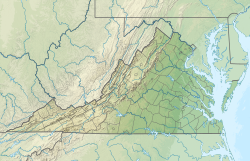
Back Norþfolc (Firginiæ) ANG نورفولك (فرجينيا) Arabic نورفولك (ڤيرچينيا) ARZ Norfolk (Virxinia) AST Norfolk (Virciniya) Azerbaijani نورفولک، ویرجینیا AZB Норфолк (Виргиния) Bashkir Norfolk, Virginia BAR Норфалк (Вірджынія) Byelorussian Норфалк (Вірджынія) BE-X-OLD
Norfolk | |
|---|---|
| Motto(s): Crescas (Latin for, "Thou shalt grow.") | |
 Interactive map of Norfolk | |
| Coordinates: 36°50′49″N 76°17′07″W / 36.84694°N 76.28528°W | |
| Country | United States |
| State | Virginia |
| County | None (independent city) |
| Founded | 1680 (as town) |
| Incorporated | 1736 (as borough) |
| Incorporated | 1845 (as city) |
| Government | |
| • Mayor | Kenny Alexander (D) |
| Area | |
| 96.40 sq mi (249.68 km2) | |
| • Land | 53.27 sq mi (137.98 km2) |
| • Water | 43.13 sq mi (111.70 km2) |
| Elevation | 7 ft (2.1 m) |
| Population (2020) | |
| 238,005 | |
| • Rank | 100th in the United States 4th in Virginia |
| • Density | 4,468/sq mi (1,725/km2) |
| • Urban | 1,047,869 |
| • Metro | 1,725,246 (37th) |
| Time zone | UTC−5 (EST) |
| • Summer (DST) | UTC−4 (EDT) |
| ZIP Codes | 23501–23515, 23517–23521, 23523, 23529, 23541, 23551 |
| Area code(s) | 757, 948 |
| FIPS code | 51-57000[2] |
| GNIS feature ID | 1497051[3] |
| Primary Airport | Norfolk International Airport |
| Light Rail | The Tide |
| Public transportation | Hampton Roads Transit |
| Website | www |
Norfolk (locally /ˈnɔːrfək/ ⓘ NOR-fək) is an independent city in the U.S. state of Virginia. It had a population of 238,005 at the 2020 census, making it the third-most populous city in Virginia and 100th-most populous city in the United States.[4] The city holds a strategic position as the historical, urban, financial, and cultural center of the Hampton Roads metropolitan area (sometimes called "Tidewater"), which has more than 1.8 million inhabitants and is the 37th-largest metropolitan area in the U.S.[5]
Norfolk was established in 1682 as a colonial seaport. Strategically located at the confluence of the Elizabeth River and Chesapeake Bay, it quickly developed into a major center for trade and shipbuilding. During the American Revolution and War of 1812, its port and naval facilities made it a critical military target. Norfolk's prominence grew in the 20th century with the expansion of the U.S. Navy, particularly through the establishment of Naval Station Norfolk in 1917, which remains the world's largest naval base.
Norfolk is an important contributor to the Port of Virginia and houses one of NATO's two Strategic Command headquarters. It is home to Maersk Line, Limited, which manages the world's largest fleet of US-flag vessels. The city has numerous cultural institutions including the Nauticus maritime museum, Chrysler Museum of Art, and Virginia Zoo. Norfolk has many miles of riverfront and bayfront areas, including beaches on the Chesapeake Bay. Its low-lying coastal infrastructure is vulnerable to sea level rise, with water levels expected to rise by more than 5.5 feet (1.7 meters) by the end of the 21st century.
- ^ "2019 U.S. Gazetteer Files". United States Census Bureau. Retrieved August 7, 2020.
- ^ "U.S. Census website". United States Census Bureau. Retrieved January 31, 2008.
- ^ "US Board on Geographic Names". United States Geological Survey. October 25, 2007. Retrieved January 31, 2008.
- ^ "QuickFacts: Norfolk city, Virginia". census.gov. Retrieved October 6, 2021.
- ^ "Where is "Tidewater" in Virginia? Hampton Roads?". Virginia Places.
© MMXXIII Rich X Search. We shall prevail. All rights reserved. Rich X Search











